
Andy Lloyd's Dark Star Blog

Blog 58 (January 2018)
New Search for sub-Brown Dwarfs Planned
Brown dwarfs are notoriously hard to find. It's not so bad when they are first born: They come into the Universe with a blast, shedding light and heat in an infantile display of vigour. But within just a few million years, they have burned their available nuclear fuels, and settle down to consume their leaner elemental pickings. Their visible light dims considerably with time to perhaps just a magenta shimmer. But they still produce heat, and the older they get, the more likely that a direct detection of a brown dwarf will have to be in the infrared spectrum.
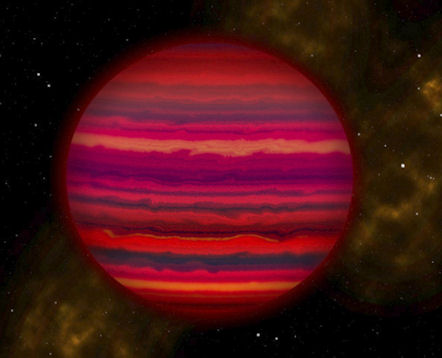
This doesn't make them much easier to detect, though, because to catch these faint heat signatures in the night sky, you first need to have a cold night sky. A very cold night sky. Worse, water vapour in the atmosphere absorbs infra-red light along multiple stretches of the spectrum. The warmth and humidity of the Earth's atmosphere heavily obscures infra-red searches, even in frigid climates, and so astronomers wishing to search in the infra-red either have to build IR telescopes atop desert mountains (like in Chile's Atacama desert), or else resort to the use of space-based platforms. The downside of the latter is that the telescopes tend to lose liquid helium supplies rather quickly, shortening their lifespan considerably compared to space-based optical telescopes.
The first major sky search using a space telescope was IRAS, back in the 1980s. Then came Spitzer at the turn of the century, followed by Herschel, and then WISE about five years ago. Some infra-red telescopes conduct broad searches across the sky for heat traces, others zoom in on candidate objects for closer inspection. Each telescope exceeds the last in performance, sometimes by orders of magnitude, which means that faint objects that might have been missed by early searches stand more of a chance of being picked up in the newer searches.
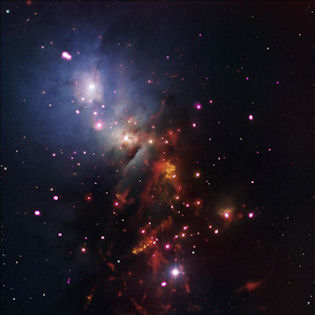
Stellar cluster NGC 1333. Image credit: NASA/CXC/JPL
The next big thing in infra-red astronomy is the James Webb Space Telescope (JSWT), due for launch in Spring 2019. The JSWT should provide the kind of observational power provided by the Hubble Space telescope - but this time in infra-red. The reason why astronomers want to view the universe in detail using infra-red wavelengths is that very distant objects are red-shifted to such a degree that their light tends to be found in the infra-red spectrum, generally outside Hubble's operational parameters (1). Essentially, the JWST will be able to see deeper into space (and, therefore, look for objects sending their light to us from further back in time when the first stars and galaxies emerged).
One of the advantages of this shift into the red is that this extremely powerful telescope will also have the capability to seek out new brown dwarfs. Precious telescope time is currently being allocated to various teams of astronomers wanting to observe parts of the sky when the JSWT is eventually operational. Two recent announcements about these allotted slots involve brown dwarfs. The first is a closer look at a young low-mass brown dwarf which lies relatively close to the Sun, by stellar standards, and is a member of a 200-million-year-old group of stars called Carina-Near. This particular object is known as SIMP0136 (2).
SIMP0136 is a free-floating sub-brown dwarf, so its light is not obscured by the presence of a parent star. This makes it a lot easier to study, providing the opportunity to analyse the components of its cloudy atmosphere. Brown dwarfs cover a reasonably broad swathe of masses, generally thought to be from about 13 Jupiter masses (mJ) up to about 80 mJ (at which point they light up into red dwarfs). SIMP0136 lies at the very lowest end of this brown dwarf range of masses, at about 13 mJ (3), which also places is at the top end of the next set of objects - the sub-brown dwarfs. Technically, at this lowly mass, it could be considered a planetary mass object rather than a stellar object. Sub-brown dwarfs are, in effect, massive gas giant almost-stars. We're likely to find out a lot more about the properties of these objects as a result of this study.
The second JSWT project announcement aims to study the NGC 1333 stellar nursery, located in the constellation of Perseus (2). This nebula contains a great many birthing stars and young brown dwarfs and is thought to also contain an abundance of sub-brown dwarfs. It's difficult to spot sub-brown dwarfs at the best of times, but the search for them is all the more difficult here because of the obscuring clouds of gas and dust within the nebula. A powerful infra-red search should allow them to pop out from their cosmic hiding place:
"Stars and planets that are just forming lie hidden behind cocoons of dust that absorb visible light. (The same is true for the very center of our galaxy.) However, infrared light emitted by these regions can penetrate this dusty shroud and reveal what is inside." (1)
Not only is this a critical factor when trying to search for free-floating planetary mass objects within nebulae, but this issue also underpins my hypothesis seeking to explain the current lack of detection of distant planets in our own solar system.
There is a persistent and - arguably - growing body of indirect evidence for the existence of one or more Planet X objects lying in very distant locations in our own solar system. Yet, such objects seem to evade direct detection. This is, of course, very frustrating for the astronomers seeking out Planet X (or Planet Nine as some have renamed it (4)), and provides grist for the mill for sceptics wishing to discredit the entire concept. For a few years, I have argued that localised nebulae may form around planetary mass objects located outside of a star's heliopause. Without the wafting action of the solar wind, and other dynamical processes driven by a star's proximity, interstellar dust may accumulate slowly around an externally located massive planet. The planet then becomes embedded within a dusty shroud, obscuring it from view in the visible spectrum (5).
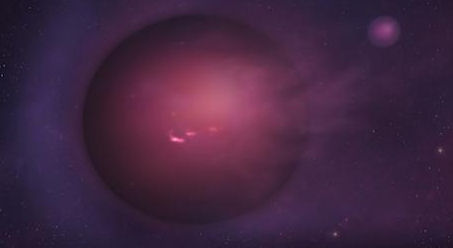
This means that searches using normal optical telescopes, like the Subaru telescope in Hawaii, are bound to fail to find Planet Nine. Furthermore, infra-red sky searches like WISE might pick up an infra-red signal, but efforts to then confirm the presence of a ninth planet using standard telescopes would also fall short (or, at least, detect a faint, fuzzy mass, rather than a distinct object). So, the infra-red signal (and commensurate visible fuzz) would be attributed to a different phenomenon.
Could the powerful JSWT change matters? I don't believe so. The telescope would need to be specifically trained in on candidate objects. Without candidate objects to examine (thus far there is exactly none) then precious observation time using the telescope will not be allocated to a Planet X project. Without a wider appreciation of the potentially variant properties of externally located planets, the status quo will remain in place: Strong indirect evidence of a massive perturbing influence, but zero prospect of actually spotting it.
Written by Andy Lloyd, 7th January 2018
References:
1) JWST "Webb vs Hubble Telescope" NASA,
2) Leah Ramsay "NASA’s Webb Telescope to Investigate Mysterious Brown Dwarfs" 4 January 2018 with thanks to Monika
3) Carnegie Institution for Science Press Release "Surprise! When a brown dwarf is actually a planetary mass object" 9 May 2017
4) K. Batygin & M. Brown "Evidence for a Distant Giant Planet in the Solar System" The Astronomical Journal, 151: 2, 20 January 2016,
5) Andy Lloyd "The Cumulative Effect of Intermittent Interstellar Medium Inundation Upon Objects In The Outer Solar System" Feb 2016, DOI: 10.13140/RG.2.1.5112.5526 - an updated version (22/2/16) is available here:
'Nibiru In-Coming', and All That Jazz
There was a time when I used to do quite a few interviews on radio, and for online video content. The peak period of the interest in the return of Sitchin's planet Nibiru (1) was during the five years running up to 2012. I would provide as much information as I could about Planet X, brown dwarfs, and the evidence underpinning the potential for further planets in the solar system. Always, we would end up discussing the same questions: When is Nibiru returning, and is this particular period in history the 'End of Days' spoken of various prophecies?
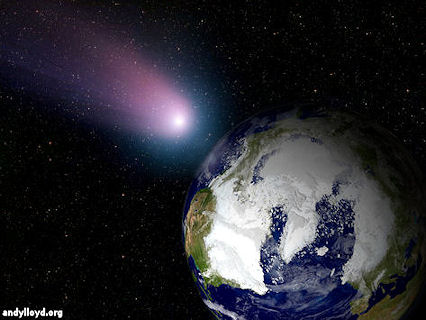
Over the years, other researchers have routinely promulgated the concept of the imminent return of Nibiru, predicting calamity and destruction for our wayward world. I'm losing count of them - each holds onto a specific date as the point of return, only to be replaced a couple of years later by another gloom-filled researcher when the previous portentous date sails past uneventfully. Happily, my honest opinion of all this has remained exactly the same for the last 20 years that I have been writing about Nibiru and Planet X: It's not around the celestial corner, hiding behind the Sun, or cloaked by some artificial force shield, or the like. Instead, Planet X is a distant, dark object pitched out among the comets. It may be a terrestrial-sized planet, or a super-Earth, or an ice giant, or a gas giant, or even a sub-brown dwarf (2). The bigger the mass, the more distant the object must lie to have evaded detection.
None of these possibilities allows for a current location among the known planets. No chance.
Twenty years on, my consistent argument remains the same: A cometary planet emerging from the outer solar system into the inner solar system would be a backyard telescope object while it is still beyond Saturn, and would gradually become a visible object between Saturn and Jupiter. The bigger it is, the sooner we'd see it. The sooner we'd ALL see it.
Planets move in Keplerian elliptical orbits around the Sun that obey laws of physics, dancing around one another as they all proceed in their orderly and predictable fashions. So, too, with Planet X. As the Earth moves around the Sun, our night-time view of various parts of the solar system shifts, so that over time we can view pretty much all of it. There's only one place to hide for any length of time, and that's if another Earth were to exist in Earth's 180 degree Lagrangian point on the opposite side of the Sun. Its orbit would have to be one Earth year, just like ours. Any other orbit would bring an object obscured by the Sun into view at some point, and then it would move progressively further away from the Sun with time. Objects said to be 'hiding behind the Sun' cannot play peek-a-boo with us.
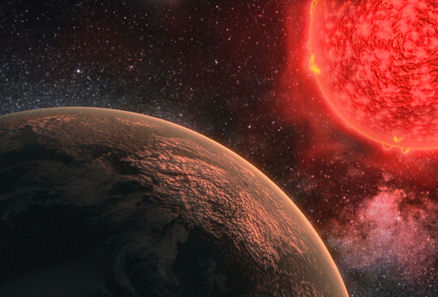
But, you know, none of this straightforward reasoning seems to make the slightest bit of difference to people who get the Nibiru cataclysm bug. Back in the old days, radio interviewers would quickly realise that I was not about to provide scientific credibility for a concept that sells books and creates hits on websites and that scares people. I'd just stick with the facts, and stay as close as I could to rational reasoning. Maybe I started sounding bored and frustrated with arguing this same point (can you blame me? 1999, 2003, 2012, 2013, 2017; it goes on and on...). Maybe the world changed its view of complex analysis, and simply stopped listening. After all, we have a conspiracy theorist in the top job these days, giving conspiracy theory both a tacit official acknowledgement, and the kiss of death. Either way, I don't get asked by the media to present 'the middle way' these days. I don't think there's much call for the middle way, generally. Not true in every case, but there's definitely a trend.
The argument about Nibiru/Planet X is so polarised now that there is little room in the middle. The thinking within the media is that you're either a 'believer' who thinks the world is about to end at the hands of a head-on collision with a fabled planet, or an 'expert' who has absolutely no time for anything Planet X-related (TV scientists don't specialise in this subject, and have little time or interest to investigate it in any depth, yet will happily provide rent-a-quote sceptical responses).
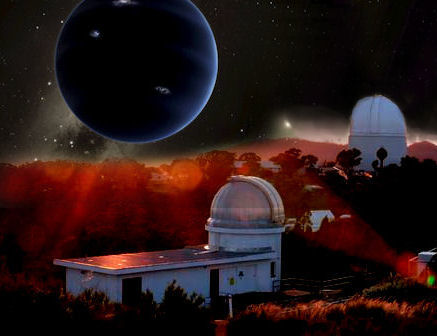
To start 2018 off in much the same vein I have become aware of the video blogs on YouTube by one Matt Rogers (3). A fellow Brit. Let me tell you something about the Planet X scene in the U.K., just for a bit of context. Besides the odd mumble down in London, there isn't one. I've been banging a solitary drum on this topic for decades. So, in a way, I welcome a fellow Brit who stands up and discusses Sitchin's Nibiru, and who appeals for an open-minded debate about this topic. And Matt's certainly managed to attract the attention of the British tabloids, which I never have (that's probably a good thing, let's be honest). Matt's videos have been providing plenty of easy copy for Jon Austin at the Express (4, 5, 6, 7, 8, 9, 10). Jon's evident passion for the subject has proven somewhat contagious, having been picked up by the Daily Mail (11) and the Daily Star (12), and even - coolio - the Lad Bible (13). Kudos.
The problem is that the sensational material being offered is erroneous and pretty easily dismissed (as described above, and see also (14)). Matt's evidently well-meaning intention to raise the profile of Nibiru among the general population is at once effective, but also calamitous.
A proper discussion of Planet X does not readily lend itself to tabloid sound-bites and sensationalism. It doesn't rely upon dodgy photo footage of lens flares and colourations in the sky. Instead, the real evidence lies in scientific data, much of it provided by world-class instruments and space-probes. The real evidence involves patterns of gravitational anomalies affecting swathes of outer solar system objects, missing masses, missing angular momentum, anomalous orbits, tilted obliquities, ridiculously complex mainstream theories of solar system formation, and so on.
But, here's the thing. This does not make good copy for hacks. Contrary to popular opinion, it also does not sell books.
We live in an age when Truth has become a personal thing. I don't want to detract from Matt Rogers' right to speak his truth to the world. I rather admire his nerve in the face of the torrent of ridicule he has faced (as well as death threats, apparently). But I also find this frustrating, because this subject is very, very vulnerable to distortion by the media. The kinds of creative claims put forward by Matt, and his predecessors, simply fuel that tendency. In the mind of the public, then, Planet X becomes a bonkers conspiracy theory denounced by every scientist they've ever heard of (about three). The real mystery is quickly lost in the noise.
But, let me assure you, there really is an excellent case for the existence of Planet X. And if it really is out there, then its eventual discovery would be very sensational indeed.
Written by Andy Lloyd, 11th January 2018
References:
1) Zecharia Sitchin "The Twelfth Planet" Avon Books 1976
2) Andy Lloyd "Dark Star: The Planet X Evidence" Timeless Voyager Press 2005
3) Matt Rogers "Sky Watcher' YouTube [Channel removed] with thanks to Scott
4) Jon Austin "NIBIRU DOOM: Is this first image of Planet X before 'end of the world' on September 23?" 19 September 2017
5) Jon Austin "NIBIRU ALMOST ON US? 'Sky and sun change colour in sign of Planet X and end of the world'" 16 October 2017
6) Jon Austin "They know NIBIRU'S COMING! Governments 'cloaking out Planet X' as it's 'about to hit'" 17 October 2017
7) Jon Austin " 'UNDENIABLE NIBIRU' The signs in sky that 'prove Planet X is in our solar system'" 2 November 2017
8) Jon Austin "NIBIRU MEDIA BLACKOUT? Shock claims over mainstream media 'Planet X cover up'" 10 November 2017
9) Jon Austin "'NIBIRU?' Nasa urged to declare 'Planet X TRUTH' amid claims 'ISS has been evacuated'" 15 November 2017
10) Jon Austin "NIBIRU SHOCK CLAIM: 'Moon isn’t real – it’s a simulation to COVER UP Planet X'" 4 December 2017
11) Shivali West "Is the government hiding evidence of Planet X? Conspiracy theorist claim world leaders are spraying our skies with chemicals to stop us seeing mythical world 'Nibiru'" 6 December 2017
12) Tom Towers "Doom planet Nibiru 'ALREADY affecting weather on Earth as apocalypse nears" 8 November 2017
13) Jess Hardman "There's a new Conspiracy Theory about Planet X, which ropes the Moon in too." 5 December 2017
14) Robert Walker "Debunking ‘Prophet for Profit’ Matt Rogers - why pink sunsets are normal - and how the Earth’s pole shifts only slowly over 26,000 years."
'Oumuamua's Many Cousins
The interstellar asteroid 1I/2017 U1 (otherwise known as
1I/'Oumuamua) is fast receding into the distance,
towards the constellation of Pegasus (1). The
existence of this rocky visitor from the stars was
announced last October (1). Its trajectory was too
fast for it to be a solar system comet - even one from
the furthest reaches of the Oort Cloud. That was
an exciting discovery, because that meant that 1I/2017
U1 was the first confirmed observation of an object
arriving in the solar system from deep space.
Image Credit: European Southern Observatory/M. Kornmesser
Although 1I/2017 U1 was initially considered to be an
interstellar comet, that thinking changed when it failed
to emit any gases as it performed its perihelion transit
around the Sun (3). This barren rock, confirmed as
an interstellar asteroid (4), is now speeding away from
the Sun. It spent a relatively short time in the
observation zone of professional telescopes, thanks to
its great speed, but this was enough to reveal more
weirdness (5). It is an elongated, cigar-shaped object
tumbling
head over tip, doing cartwheels through the solar
system (4). Its lack of cometary coma flies in the
face of conventional wisdom about interstellar debris,
the vast majority of which is theorised to be cometary,
rather than asteroidal (4). 'Dry' objects in
comet-like orbits, but which behave like asteroids, have
been discovered, and are known as Manx-type comets.
Some wondered whether it might be
artificial, given the weird lack of coma as it traversed past
the Sun. But attempts to pick up signals from the
object came up blank (6). Still, its shape is
nothing like any known body in our Solar System.
If solar system asteroids resemble rocky potatoes, then
1I/2017 U1 is more like an interstellar carrot, spinning
haphazardly through our system. To remain intact
under these conditions, its internal structure must be
robust (7).
The colour of our interstellar carrot is neutral with a reddish hue.
The colouration may be patchy across its surface. Solar system minor
bodies (asteroids, Kuiper Belt Objects, Trojans) vary in colour, often
dependent upon which population group any particular object belongs to.
Continuing my daft vegetable analogy, solar system potatoes come in
different varieties. Many are neutral in colour, some are reddish,
others distinctly red. Like comparing a Maris Piper to a King
Edward. If we compare 1I/'Oumuamua's colouration to those of
various classes of solar system objects, then it seems to most resemble
those of the dynamically excited populations of Kuiper Belt Objects.
However, it is less red than the scattered Trans-Neptunian objects whose
orbits extend beyond the heliopause (7).
Sharply varying brightness of `Oumuamua
indicates a thin, tubular shape. Dots indicate brightness measurements.
Image Credit: ESO/K. Meech et al
This creates a slight conundrum, because the red appearance of these
more distant travellers has been attributed to their exposure to cosmic
radiation beyond the protective 'shield' of the heliosphere (8).
This causes the polymerisation of surface organic materials, creating 'ultrared'
compounds whilst moving through interstellar space beyond the heliopause.
The problem, then, is reconciling that idea with an asteroid from
interstellar space. If such an object were to have surface organic
materials present, as many outer solar system objects do, then its
interstellar flight from its own original solar system should have
turned these materials deep red. That is not what has been
observed. One possibility is that 1I/2017 U1 is a shard of
material ejected from a star's inner system, where volatile organic
materials would already have been eradicated from the object's surface
by the action of the star. There are other possibilities, too: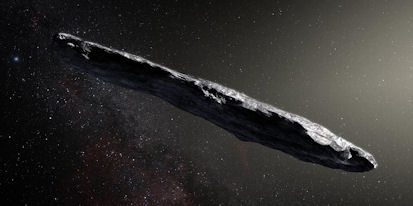
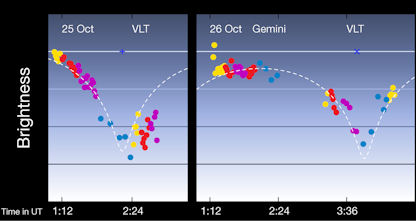
"1I/'Oumuamua's largely neutral color opens up a number of possibilities. It could imply that the correlation of ultra-redness with heliocentric distance has an alternative cause. It could suggest that 1I/'Oumuamua formed with an organics-poor surface within its star's water ice line. 1I/'Oumuamua's color being within the observed range for minor planets in the solar system could support that 1I/'Oumuamua originated from a star from the Sun's birth cluster, which should have a similar chemistry. A possible additional complication could be resurfacing due to surface activity, which would affect surface color. This seems unlikely as no surface activity was detected during 1I/'Oumuamua's perihelion passage, but 1I/'Oumuamua could have had past activity in its origin system or in another close encounter." (7)
As 1I/2017 U1 is a solitary object in a class of its own, it's impossible to tell whether its properties are typical of interstellar asteroids or not. However, if its solitary arrival on our cosmic shores presents a statistical norm over the time we have been actively seeking out such objects, then calculations suggest there is an absolutely massive population of interstellar asteroids across the galaxy (9).
"Gregory Laughlin of Yale University and Konstantin Batygin of Caltech...argue that [1I/'Oumuamua's] current passage, if it’s not a fluke, suggests the presence of an enormous number [2 x 10 to the power 26 (8)] of such objects in our galaxy alone — enough to account for two Earth-masses of material for every star in the galaxy." (5)
That's an awful lot of ejected material being flung about out there. The currently accepted model of solar system formation, the Nice model, predicts this effect, whilst simultaneously recognising that it's not that easy to eject material from the gravitational field of a star. The 'throw line' of each star system varies with the mass of the star. According to the Nice model, stars would need to have substantial planets placed in the right orbital locations to facilitate these ejections. It is thought that each star system would need the presence of gas giant world/s and, in particular, its own equivalent of a distant Neptune to make this happen:
"Our own solar system has contributed many volatile-rich planetesimals to the galaxy. Within the framework of the so-called Nice model of early solar system evolution, a transient period of dynamical instability is triggered in response to interactions between the giant planets and a primordial disk. In simulations, nearly all of this material is expelled into interstellar space as the instability unfolds, leaving behind today's mass-depleted Kuiper Belt... Efficient ejection of planetesimals requires a massive secondary body with specific orbital conditions." (9)
However, our solar system seems to have a different layout of planets from other planetary systems which have now been observed and studied. In other systems, small planets seem to team up with other small planets, like regularly-placed peas in a pod. Conversely, large planets pair up in other systems (10). So, the Nice model's application to our own, unusually mixed-up system may not work so well with other planetary systems - at least, if you're trying to explain mass expulsions of rocky materials across the galaxy.
The lack of volatiles on 1I/2017 U1 confuses matters further. It restricts the conditions of ejection from a star system still further. Laughlin and Batygin seem to imply that 1I/2017 U1 does contain volatiles, despite its distinct lack of cometary activity during perihelion. This would fly in the face of what was observed during the transit. They argue that, otherwise, each planet must be ejecting a phenomenal amount of material:
"If A/2017 U1 points to a volatile-bereft population, each such planet must eject >100 (Earth masses). In all likelihood, the comparatively low occurrence rate of these planets allows them only minor contributions, implying that A/2017 U1 is volatile-rich despite its lack of coma. Interstellar asteroids are likely ejected by as-yet unobserved long-period sub-Jovian planets." (9)
If anything about this is clear at all, it's that 1I/2017 U1 is creating a great many challenges! It seems reasonable to conclude that a large population of interstellar asteroids implies a large population of sizeable planets in long-period orbits around stars. If interstellar objects are largely volatile-free, as seems to be the case here, then the amount of material being ejected during the early life of a planetary system is truly astounding.
"If the typical ISO [interstellar object] is asteroid-like then the ISO number density could be much higher than contemporary limits because models assume that cometary material is more likely ejected and cometary ISOs should be the easiest to detect because of selection effects." (4)
But then the Nice model calls for early solar system catastrophism on a truly awesome scale, so a galaxy littered by similar debris from other stars seems in keeping with this. The sticking point is that pesky lack of volatiles.
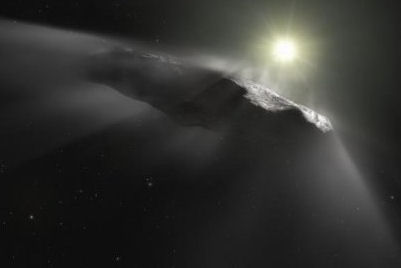
None of this explains the curious shard-like shape of 1I/2017 U1, though. This seems to me, from a purely common sense point of view, to indicate that this object resulted from a collision, rather than having been ejected through mere gravitational interaction between bodies. It is, metaphorically, a piece of flying glass. Other possibilities exist. Although the colouration of the object may be patchy, it is not so variable to imply we are simply observing a strip of reflected light across a rounded, dark body. Similarly, the idea that 1I/'Oumuamua is actually a bi-lobate body, or even a linear collection of strewn debris has been ruled out (4). As for its origin, it still cannot be completely certain that this is isn't an object from the outer solar system, perturbed into a hyperbolic orbit by an encounter with an as yet undiscovered planet:
"Although we believe it unlikely that an undiscovered planet could have produced the motion of ‘Oumuamua, we cannot yet rule it out. A deep search for distant planets in the radiant direction of ‘Oumuamua would help to confirm or reject this possibility." (4)
In that regard, it is interesting that 1I/'Oumuamua comes from the direction of the Solar Apex, the point in the sky towards which the Sun is travelling through space. As I noted when the announcement was first made, this object's encounter with the Sun is like a gnat splatting directly into the windscreen of a moving car (2). I have wondered before whether the Solar Apex may be coincident with a distant companion object in the very depths of the solar system (11). But, as noted in the scientific paper about 1I/2017 U1, this seems a remote possibility. That said, a random encounter with another object in interstellar space seems even more remote, given the probable low density of objects out there (12). So, if the tumbling effect didn't kick off when the object was ejected from its home system, then it is hard to see how this rotational movement started up, without inferring a Planet X-like encounter.
Everything about this object is pretty weird. Maybe it's just the universe reminding us to expect the unexpected.
Written by Andy Lloyd, 21st January 2018
References:
1) The Sky Live "1I/2017 U1 (Oumuamua)"
theskylive.com/oumuamua-tracker
2) Andy Lloyd "Alien Red Asteroid Crashes Through Solar System" 28 October 2017
andylloyd.org/darkstarblog55.htm
3) Andy Lloyd "Interstellar Shard Puzzles Astronomers" 13-29 December 2017
andylloyd.org/darkstarblog57.htm
4) Karen Meech et al. "A brief visit from a red and extremely elongated interstellar asteroid" Nature, 21 December 2017, 552, pp378–381, with thanks to Karen Meech.
5) Susanna Kohler "Update on an Interstellar Asteroid" 19 January 2018
6) PhysOrg "No alien 'signals' from cigar-shaped asteroid: researchers" 14 December 2017
7) Michele T. Bannister et al "Col-OSSOS: Colors of the Interstellar Planetesimal 1I/'Oumuamua" The Astrophysical Journal Letters, 18 December 2017, 851:2,
8) Dave Jewitt "From Kuiper Belt Object to Cometary Nucleus: The Missing Ultrared Matter" The Astronomical Journal, 2002, 123: 2, pp1039-1049
9) Gregory Laughlin & Konstantin Batygin "On the Consequences of the Detection of an Interstellar Asteroid". 2017 Res. Notes AAS, 1 43
10) Elizabeth Howell "Earth Resides in Oddball Solar System, Alien Worlds Show" 16 January 2018, with thanks to Shad
11) Andy Lloyd "Dark Star: The Planet X Evidence" Timeless Voyager Press 2005
12) Wesley Fraser et al '1I/‘Oumuamua is tumbling' 30th November 2017,
New Brown Dwarfs et al Found in the Orion Nebula
Astronomers have tracked down a new set of brown dwarfs
in the Orion Nebula, by searching for the tell-tale
signs of water vapour in their atmospheres. This is best
achieved using space-based infrared telescopes, and the
Hubble Space Telescope is equipped with a near-infrared
detector. It has been used to spot over a thousand
candidate objects in the nebula. Many of these
objects turned out to be background stars, whose light
had been turned redder by the intervening nebula dust.
A Hubble image of the Orion Nebula.
Image credit: NASA /
ESA / M. Robberto, Space Telescope Science Institute & ESA / HST Orion Treasury Project Team
(2)
Some of these turned out to be brown dwarfs, of various
masses, and in variable partnership arrangements:
"Because brown dwarfs are colder than stars,
astronomers used Hubble to identify them by the presence of water in
their atmospheres. “These are so cold that water vapor forms,” explained
team lead Massimo Robberto of the Space Telescope Institute in
Baltimore, Maryland. “Water is a signature of substellar objects. It’s
an amazing and very clear mark. As the masses get smaller, the stars
become redder and fainter, and you need to view them in the infrared.
And in infrared light, the most prominent feature is water... In all,
the team found 17 candidate brown dwarf companions to red dwarf stars,
one brown dwarf pair, and one brown dwarf with a planetary companion.
The study also identified three potential planetary mass companions: one
associated to a red dwarf, one to a brown dwarf, and one to another
planet.” (1) The
astronomers conducting this work used similar detection techniques used
for searching for exoplanets orbiting around stars, but they adapted the
techniques for use in high-quality snapshots of an entire region rich
with new stars and planets (3). This trawl allowed them to find a
good crop of new objects for further study. It is a refined
technique which could be used to trawl through Hubble's entire near
infra-red archive, opening the possibility of many more discoveries in
the future.
Written by Andy Lloyd, 21st January 2018
References: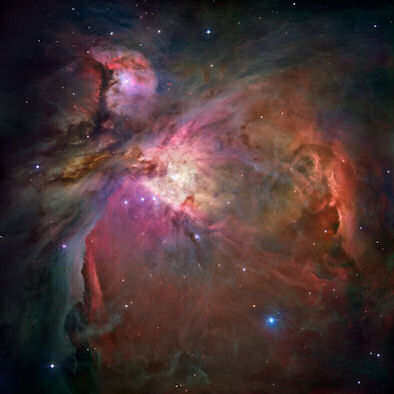
1) Ann Jenkins & Ray Villard "Hubble Telescope Discovers Substellar Objects in the Orion Nebula" 12 January 2018, Space Telescope Science Institute
2) Sci-News Staff "Hubble Finds Three Giant Exoplanets and Several Brown Dwarfs in Orion Nebula" 12 January 2018, with thanks to Monika
3) Giovanni Maria Strampelli et al. "A HST/WFC3 Search for Substellar Companions in the Orion Nebula Cluster", 231st AAS Meeting, abstract # 414.07, January 2018

You can keep informed of updates by following me on Twitter:
![]()
Or like my Facebook Page: https://www.facebook.com/darkstarandylloyd